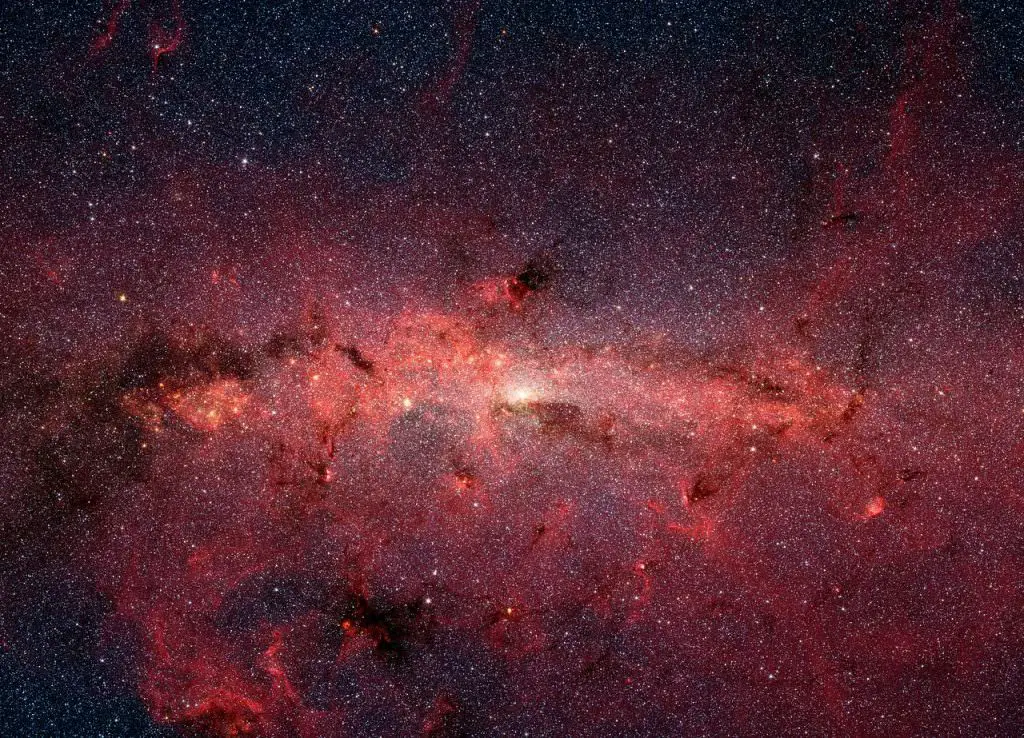The Big Bang Theory is fundamental to our understanding of the universe's origins. It explains how the cosmos evolved from an initial singularity to the vast expanse we observe today. This article examines the key principles, evidence, and developments that have shaped our comprehension of this monumental event.
Origins and Fundamentals of the Big Bang Theory
Around 13.8 billion years ago, the universe began with an event known as the Big Bang. This wasn't an explosion but an intense expansion from an incredibly dense and hot point, a singularity. From this moment, the universe started to expand, marking the beginning of cosmic time.
The Big Bang Theory emerged in the early 20th century due to observations and advances in theoretical physics. Key contributors include:
- Alexander Friedmann: Developed equations from Einstein's theory of general relativity, showing the universe's expansion
- Edwin Hubble: Provided crucial evidence by observing distant galaxies moving away from us, leading to Hubble's Law
- Georges Lemaitre: Posited that the universe began from a singular point, now termed the Big Bang
Cosmic inflation, a brief yet crucial period shortly after the Big Bang, involved rapid expansion at unimaginable speeds. This inflationary period, proposed by physicist Alan Guth in 1980, solved several conundrums about the uniformity and structure of the universe.
Initial conditions right after the Big Bang were extreme. The universe was a seething cauldron of energy, with temperatures about 10 billion degrees Fahrenheit. In the first microseconds, quarks and gluons combined into protons and neutrons. This energized soup gradually cooled enough for particles to form hydrogen and helium nuclei.
The Cosmic Microwave Background (CMB) radiation, a faint glow detectable in all directions, provides strong confirmation of the Big Bang Theory. Discovered in 1965 by Arno Penzias and Robert Wilson, the CMB is essentially the afterglow of the Big Bang, radiation left over from when the universe became transparent, about 380,000 years post-expansion.
These scientific milestones collectively forged the Big Bang Theory, offering a cohesive explanation for the universe's birth and continuous expansion. The theory remains a cornerstone in our understanding of the universe's beginnings, setting the stage for everything—matter, light, and the very fabric of space and time.
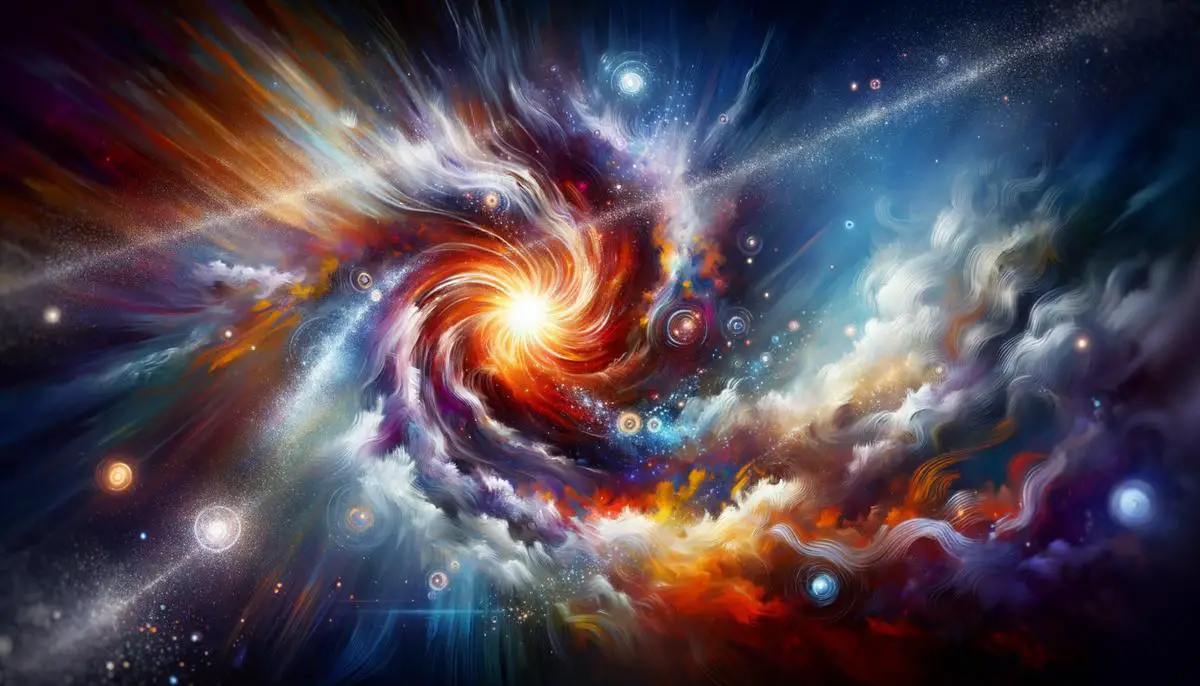
Evidence Supporting the Big Bang Theory
The Big Bang Theory is supported by multiple strands of empirical evidence. Key pieces of evidence include:
- Cosmic Microwave Background (CMB) radiation: A faint, almost uniform glow permeating the universe, serving as a key observational backbone. Detected by Arno Penzias and Robert Wilson in 1965.
- Hubble's Law: Identifies a relationship between distance and the recessional velocity of galaxies, indicating an expanding universe.
- Light element abundance: The relative proportions of hydrogen, helium, and trace amounts of lithium and beryllium correlate remarkably well with theoretical predictions.
- Dark matter and dark energy: Though elusive, these components play crucial roles in our understanding of cosmic structure and expansion.
Detailed maps produced by missions like NASA's Cosmic Background Explorer (COBE), Wilkinson Microwave Anisotropy Probe (WMAP), and the European Space Agency's Planck satellite have confirmed the CMB's uniformity and slight anisotropies. These minor temperature variations are the fingerprints of primordial density fluctuations, which later evolved into galaxies and large-scale structures.
The abundance of light elements was synthesized in the first few minutes post-Big Bang, during Big Bang Nucleosynthesis (BBN). This process substantiates the extreme conditions of the universe's nascent moments.
"The cosmic microwave background radiation is the afterglow of the big bang, the leftover heat of creation that bathes the entire universe." – Stephen Hawking
Dark matter, which interacts primarily through gravity, makes up approximately 23% of the universe's total matter-energy content. Its presence was inferred from gravitational effects on visible matter. Dark energy, constituting about 72% of the universe, plays a pivotal role in accelerating cosmic expansion.
These pieces of evidence collectively cement the Big Bang Theory's standing, reinforcing a cohesive picture of a universe in dynamic flux since a singular, transformative event 13.8 billion years ago.1
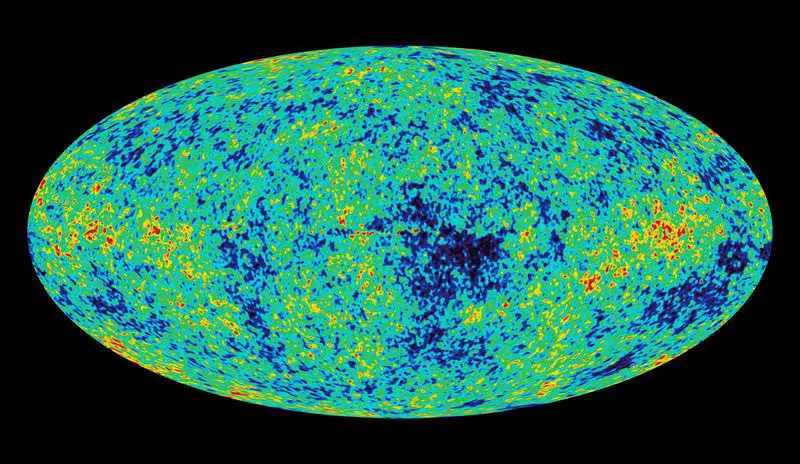
The Evolution of the Universe Post-Big Bang
The universe's journey from the Big Bang to its present state encompasses several cosmic epochs. Here's a timeline of key events:
| Epoch | Time After Big Bang | Description |
|---|---|---|
| Planck Epoch | 0 to 10-43 seconds | Most enigmatic phase where our current understanding of physics begins to blur |
| Inflation Epoch | 10-36 to 10-32 seconds | Phase of exponential expansion, smoothing out initial irregularities |
| Cooling Epoch | 10-6 seconds to 1 second | Quarks and gluons combined to form protons and neutrons |
| Big Bang Nucleosynthesis | Few minutes | Formation of lightest elements: hydrogen, helium, and small amounts of lithium and beryllium |
| Recombination | ~380,000 years | Electrons combined with protons and helium nuclei to form neutral atoms |
| Reionization Epoch | ~150 million to 1 billion years | First stars and galaxies formed, reionizing intergalactic hydrogen |
As the universe expanded and cooled, gravity began to assert its influence more prominently, pulling matter into denser regions and forming gas clouds. These gas clouds collapsed under gravity, eventually igniting nuclear fusion in their cores, giving birth to the first stars.
These nascent stars contributed to the chemical enrichment of the universe by producing heavier elements in their cores and dispersing them through supernova explosions. Moving further along the cosmic timeline, galaxies formed from these gas clouds and early stars. Gravity pulled galaxies into clusters and superclusters, giving rise to the large-scale cosmic web that defines the universe's structure.
Each of these epochs contributed to the rich composition of our universe. Understanding these stages provides valuable insights into the physical laws governing our reality, advancing our quest to comprehend the universe's enigmatic origin and its spectacular evolution.2
Alternative Theories and Challenges to the Big Bang
While the Big Bang Theory remains the leading explanation for our universe's origins, alternative theories have been proposed. The Steady State Theory, prominent in the mid-20th century, suggests an eternal and unchanging universe that continuously creates new matter. However, the discovery of the Cosmic Microwave Background (CMB) radiation and observable redshift of distant galaxies provided strong evidence for the Big Bang model.
The Oscillating Universe Theory proposes cycles of expansion and contraction, appealing to the notion of a self-sustaining cosmos. However, it faces challenges such as the entropy problem, where each cycle would accumulate heat and disorder.
The Big Bang Theory itself faces unresolved questions, particularly concerning dark matter and dark energy. Dark matter, inferred through gravitational effects on visible matter, adds complexity to our understanding of the universe. The Lambda-Cold Dark Matter (Lambda-CDM) model has been instrumental in explaining large-scale cosmic structures, but the exact nature of dark matter remains elusive.
Dark energy, constituting about 72% of the universe, drives the accelerated expansion of the cosmos. The Cosmological Constant in Einstein's field equations has been repurposed to describe this repulsive force, but its true nature and operation within quantum mechanics and general relativity remain significant conundrums.
Challenges to the Big Bang Theory:
- The early moments of the universe, particularly the Planck Epoch
- The horizon problem
- The flatness problem
Concepts like string theory and loop quantum gravity are promising avenues for a comprehensive theory of quantum gravity, but concrete, testable predictions remain out of reach. The inflationary model provides compelling solutions to the horizon and flatness problems but awaits further empirical substantiation.
Despite these challenges, the Big Bang model has stood resilient, continually corroborated by empirical evidence. As technology advances and new observations arise, our understanding of cosmic origins may evolve, possibly revealing deeper layers of understanding or even entirely new paradigms.
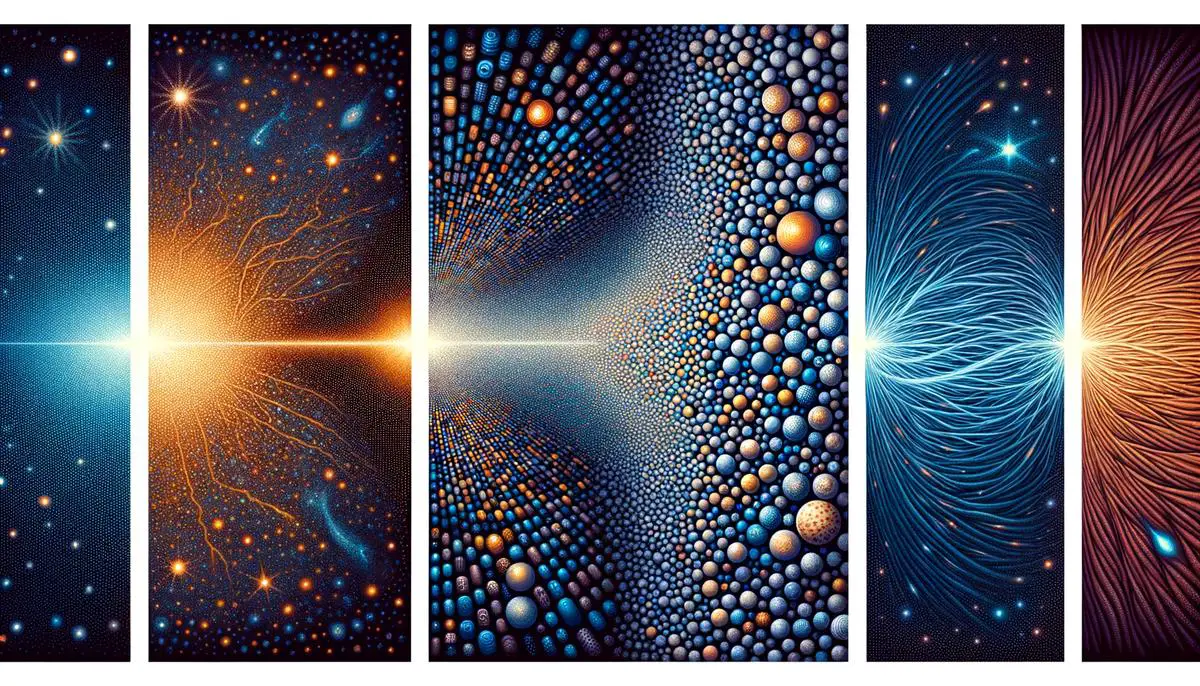
Future of the Universe: Predictions and Theories
The ultimate fate of the universe remains a compelling puzzle for astrophysicists, framed by several intriguing scenarios: the Big Crunch, Big Freeze, and Big Rip theories.
| Theory | Description | Challenges |
|---|---|---|
| Big Crunch | Universe's expansion halts and reverses, pulling all matter back into a dense singularity | Contradicts empirical data showing accelerated expansion |
| Big Freeze | Continued expansion leading to a dark, cold cosmos dominated by inert remnants | Aligns with current observations of dark energy's influence |
| Big Rip | Dark energy drives expansion to extremes, tearing apart space-time itself | Depends on uncertain evolving properties of dark energy |
Dark energy plays a pivotal role in these endgame scenarios. Constituting about 72% of the universe's total energy density, it exerts a repulsive force counteracting gravity. Hypotheses about its nature range from Einstein's cosmological constant to dynamic fields like quintessence1.
The concept of the multiverse adds another layer of complexity to these predictions. Inflationary theory suggests that different regions of space-time could create numerous "bubble" universes, each with distinct physical laws and cosmic histories2.
"The future of the universe remains a thrilling frontier for exploration and discovery, fueling the inquisitive spirit of scientists and inspiring humanity's quest to comprehend the cosmos."
As we develop new observational technologies and theoretical models, these scenarios will be refined, offering deeper insights into the grand story of our universe.
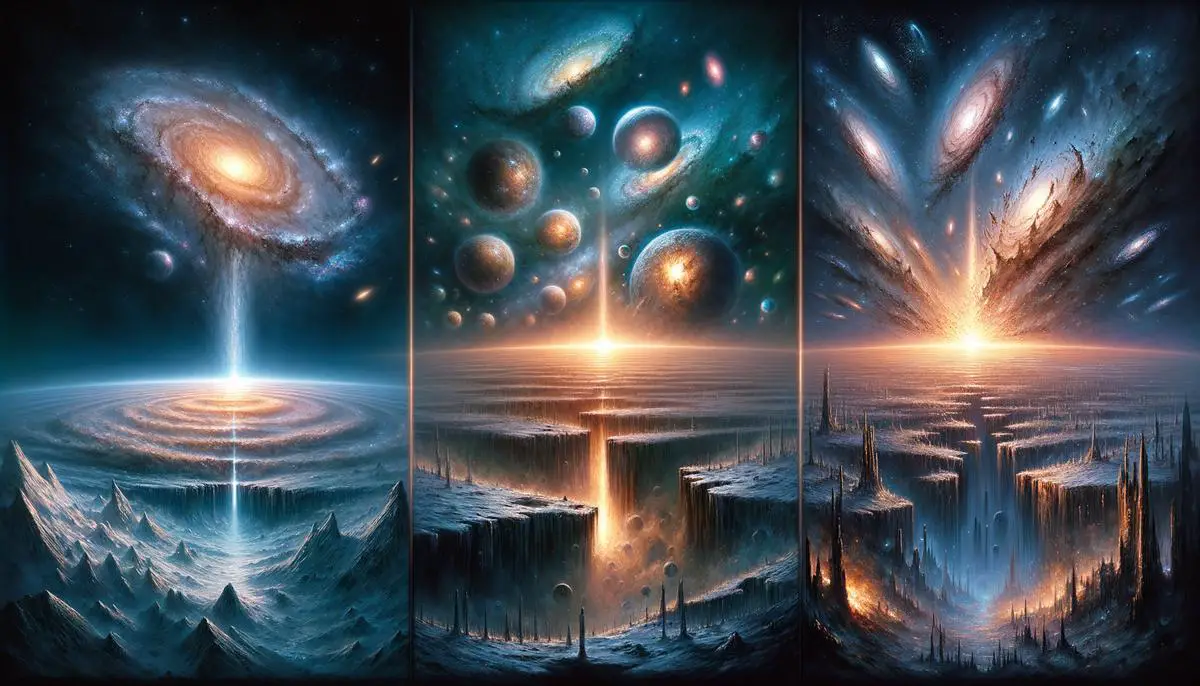
The Big Bang Theory provides a robust explanation for the universe's beginnings and ongoing expansion. While alternative theories and unresolved questions persist, the empirical evidence supporting this model remains compelling. As scientific advancements continue, our understanding of the cosmos will undoubtedly deepen, revealing even more about the universe's intricate nature.
![]()
